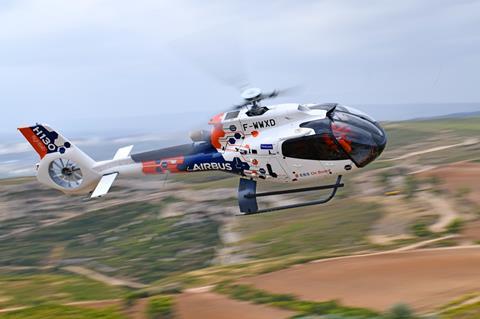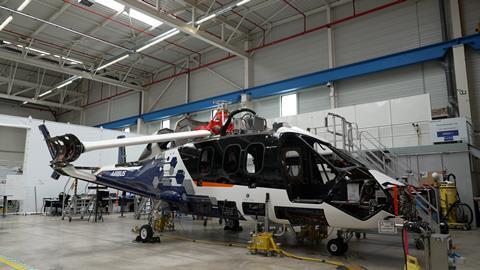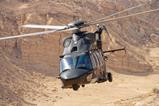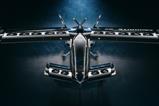Airbus Helicopters is gearing up for a busy second half of 2023 as it pushes ahead with an ambitious programme that by year-end will see it flight testing a trio of technology demonstrators.
To date, those technology demonstrators comprise the H130-based FlightLab and clean-sheet DisruptiveLab – both single-engined conventional rotorcraft – but they should be joined in the autumn by the Racer high-speed helicopter.

But even though the FlightLab and DisruptiveLab are already flying – for several years in the case of the former – both will shortly be embarking on new phases of their test campaigns.
Revealed in December, the DisruptiveLab first flew in early 2023, testing a suite of technologies designed to deliver a 50% reduction in fuel burn for future helicopter designs.
Airbus Helicopters disclosed in early June that the rotorcraft had completed its initial round of testing.
Speaking to FlightGlobal at the Paris air show on 21 June, Tomasz Krysinski, vice-president of research and innovation at Airbus Helicopters, said the DisruptiveLab’s first test phase was designed to open up the flight envelope and tune the “flight qualities” of the rotorcraft and the performance of its sensors.
But Krysinski has been impressed with the rate of progress: “In terms of the tuning it is the first time we have been able to go so quickly.”
He says the DisruptiveLab has achieved a steady flight cadence, allowing the airframer to analyse data and implement resulting configuration changes before flying again.
“Our target is not to perform flights too often – it makes no sense on a demonstrator to be in a hurry,” he says.

Feedback from Airbus Helicopters’ test pilots – four have now flown it – has been positive, says Krysinski: they describe it as “easy to handle” with very low levels of vibration.
Crucially, performance has been in line with predictions, with the helicopter’s aerodynamic improvements, such as the low-profile rotor hub, allowing the DisruptiveLab to already achieve a speed of 163kt (301km/h) in a slight dive.
Flight testing will continue throughout the remainder of 2023 and “during the second part of the testing we will start taking real performance measurements”.
Although the low-drag profile of the DisruptiveLab should contribute a 15% reduction in fuel burn, hybridisation of the powertrain should enable a further 10% cut.
So far, the helicopter has been powered solely by its thermal engine; hybridisation of the powertrain with a 250kW electric motor and batteries – able to be charged in flight – will take place next year.
This will enable 2min of powered flight in the event of an engine failure and improve fuel consumption through the optimisation of the thermal engine for high-power flight phases.
Batteries for the hybrid-electric system will be provided by Airbus Defence & Space, while a decision will be taken shortly on the supplier of the electric motor.

But details of the turboshaft engine remain scarce, save for the fact that it is supplied by Safran Helicopter Engines. Krysinski declines to be drawn on the output of the likely clean-sheet powerplant, although the same manufacturer’s Arrius 2R for the light-single Bell 505 is rated at around 500shp (372kW).
Installation of the battery-electric system on the DisruptiveLab is the airframer’s most ambitious hybridisation project to date. However, it has already evaluated a more modest capability – the Engine Back-up System (EBS) – aboard the FlightLab.
The EBS does not improve the efficiency of the gas turbine but is designed to provide short-duration emergency power should the main engine fail.
Testing of the system is complete but development work continues, paving the way for a future commercial product, says Krysinski: “It is something we continue to develop. We are working on [reducing] the cost of the overall system.”
But the FlightLab is not sitting idle: Airbus Helicopters will in July kick off a new test programme with the demonstrator, trialing a new autonomous flight-control system called Vertex.
Developed by the group’s UpNext unit and designed for vertical take-off and landing applications, the Vertex system combines data from several LIDAR and electro-optical/infrared sensors to build up a picture of the helicopter’s surroundings, enabling autonomous take-offs, landings and taxing.
Additionally, the FlightLab will be fitted with a ‘fly-by-wire’ system, replacing the collective, cyclic and pedals on one side of the helicopter with a sidestick controller, linked to the mechanical controls with a clutch-type arrangement.
Destined for the airframer’s CityAirbus NextGen advanced air mobility programme, the system, which also includes an active-trim function, is a controller for a “millennial-generation pilot”, says Krysinski.
Initially testing will focus on the sidestick and fly-by-wire system, with the complete Vertex package following later in the year.
Meanwhile, the Racer – a high-speed compound rotorcraft – is edging closer to first flight.
“We are very well advanced now. We want to take off in November,” says Krysinski.
Progress had been held up by the delayed delivery of the helicopter’s main gearbox from Avio Aero in Italy, but Airbus Helicopters has now received the component which is undergoing rig endurance testing.
A flight-ready gearbox is expected to be delivered in July, enabling ground tests of the completed Racer to begin after the summer break.
































